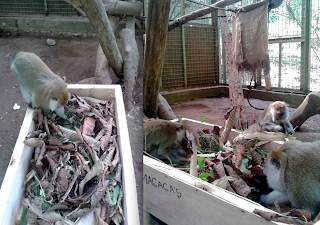Being able to do my dissertation project on macaques at the International Animal Rescue centre in Ciapus, Indonesia has certainly been a privilege, not only because it is a great opportunity to grow academically and professionally, but mainly because it has given me the chance to appreciate the magnificence of these animals while I help their rehabilitation process.
 |
| One of our rescued macaques has a snack |
Now, taking into consideration that most of these macaques come from the pet trade and have spent years in captivity (either as pets, street beggars or performers), it is very important to make sure they know how to forage for food in their own habitat - which is very different from finding food in a plate or in a human hand - so they don’t starve to death once they’re released. For this, the keepers at the centre are always trying to come up with creative ways to present the food, using puzzle feeders and feeding devices (made of natural materials such as bamboo branches and other trees) so the amount of time spent by the animals in foraging activities increases, and their foraging skills improve.
 |
| Adding the secret ingredients |
As part of my project and after talking with the keepers, we decided to make a foraging box to give the animals a small representation of what they would find in the wild. Since macaques spend some time foraging on the ground, and besides fruit they also eat insects, leaves and small vertebrates, we thought we could put some of these “ingredients” together in the box, in a way that resembled the natural appearance of their habitat: some soil covered with a thick layer of foliage, branches and rocks that they would have to manipulate to find the fruit and the insects.
Once the first box was made, we put the soil, rocks, insects, seeds, leaves and small pieces of fruit inside, put one box in a cage and then waited for the animals’ reactions...
Even though I really wanted the box to work (that would mean seeing the animals forage for at least more than a few minutes on it), I was somehow expecting them to break the box or just take everything out in a second. However, they were carefully moving and manipulating the branches, leaves and rocks to find the crickets, worms and pieces of fruit that were hidden inside. The box was big enough to let 3 macaques use it, and they didn't forage for a few minutes, but for more than 2 hours! :)
This not only gave us a clue that we were on the right direction with this new enrichment and it’s something we might be able to use in the long term, but it also showed me that I was underestimating the intelligence and abilities of these animals.
So, we are still working on some improvements for this box to see if we can increase the amount of time the animals use it, but we are excited to know we had a good start with this idea and we are looking forward to testing the new version and see if we can use it with other groups of macaques!
Once the first box was made, we put the soil, rocks, insects, seeds, leaves and small pieces of fruit inside, put one box in a cage and then waited for the animals’ reactions...
Even though I really wanted the box to work (that would mean seeing the animals forage for at least more than a few minutes on it), I was somehow expecting them to break the box or just take everything out in a second. However, they were carefully moving and manipulating the branches, leaves and rocks to find the crickets, worms and pieces of fruit that were hidden inside. The box was big enough to let 3 macaques use it, and they didn't forage for a few minutes, but for more than 2 hours! :)
This not only gave us a clue that we were on the right direction with this new enrichment and it’s something we might be able to use in the long term, but it also showed me that I was underestimating the intelligence and abilities of these animals.
So, we are still working on some improvements for this box to see if we can increase the amount of time the animals use it, but we are excited to know we had a good start with this idea and we are looking forward to testing the new version and see if we can use it with other groups of macaques!
 |
| The foraging box certainly went down well with the residents! |

No comments:
Post a Comment